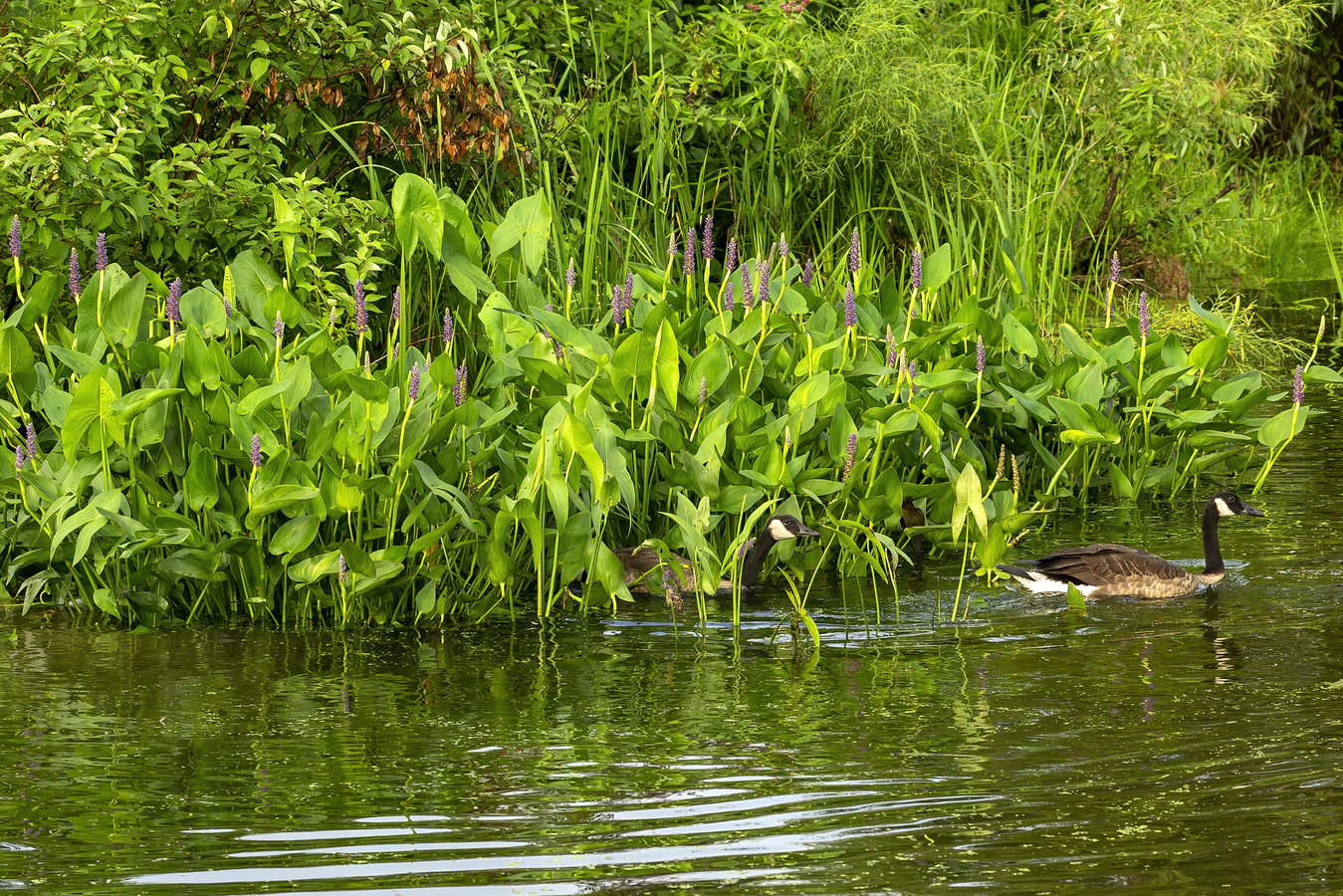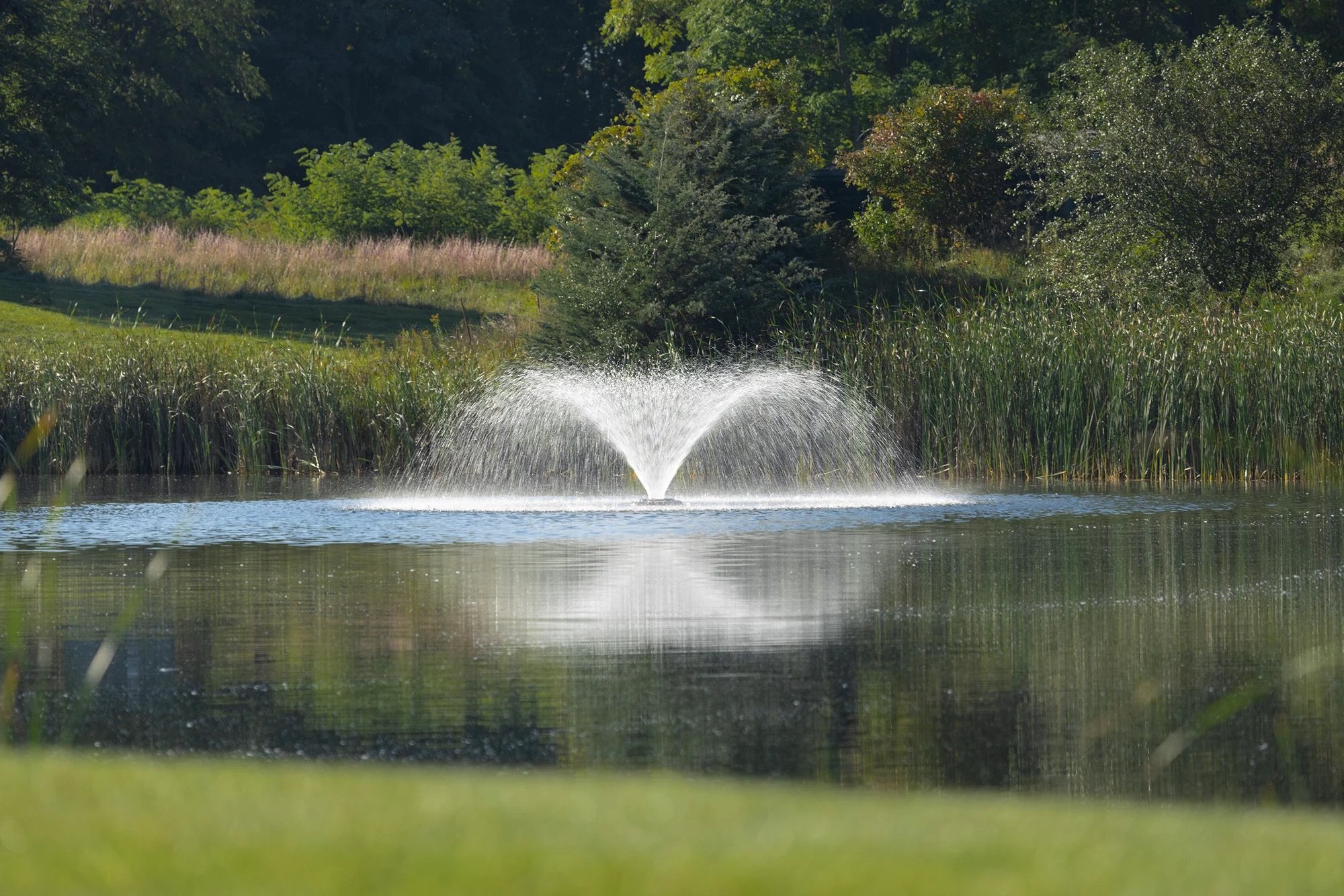
Your pond’s appearance isn’t just shaped by what’s in the water—it’s a reflection of everything that happens on the land around it. Murky water, floating algae, and overgrown weeds may seem like isolated in-pond problems, but they usually start further upstream—on lawns, driveways, pastures, and gardens within your pond’s watershed.
At Water and Wetland, we believe that successful pond management starts where runoff begins. That’s why our approach always includes watershed-focused strategies. By addressing pollution before it reaches your pond, we help protect your water quality for the long term.
What Is Nutrient Loading?
One of the biggest threats to pond health is nutrient loading, which refers to the buildup of phosphorus and nitrogen in the water. These nutrients act as fuel for algae and aquatic weeds, triggering a process called eutrophication.
Common sources of nutrient loading include:
- Lawn and landscape fertilizers
- Pet and livestock waste
- Septic system leaks
- Grass clippings and leaf litter
- Eroding shorelines
- Stormwater runoff from rooftops, roads, and compacted soils
Once nutrients enter your pond, they don’t just disappear—they accumulate in the sediment and continue feeding algae blooms for years to come.
A Better Way: Watershed-Based Pond Management
Instead of reacting to the symptoms with constant chemical treatments, proactive watershed management helps reduce nutrient input at the source. Here’s how Water and Wetland works with landowners to intercept runoff and protect water quality:
Native Buffer Zones
We design and install custom buffer zones with native wetland plants to:
- Filter runoff before it reaches the pond
- Stabilize shorelines and prevent erosion
- Discourage geese and nuisance wildlife
- Support pollinators and increase biodiversity
Native plants like sedges, rushes, and wildflowers develop deep root systems that hold soil in place while naturally absorbing excess nutrients.
Smarter Landscaping Practices
What you put on your lawn ends up in your pond. To reduce nutrient runoff, we recommend:
- Using phosphorus-free or slow-release fertilizers
- Avoiding chemical treatments within 50–150 feet of the shoreline
- Leaving a natural strip of uncut grass along the water’s edge
These simple changes often lead to visible improvements in water clarity within a single season.



Stormwater Management Solutions
Stormwater runoff is one of the leading causes of nutrient loading. To manage it more sustainably, you should consider:
- Bioswales to redirect and slow stormwater
- Rain gardens that soak up runoff from rooftops and driveways
- Constructed wetlands that filter pollutants before they enter the pond
These green infrastructure practices help protect water quality while adding beauty and habitat to your property.
Livestock and Pet Waste Control
Both livestock and pets can be major contributors of phosphorus, nitrogen, and harmful bacteria like E. coli. We recommend:
- Fencing livestock away from pond edges and sensitive wetland areas
- Providing alternative watering systems for animals
- Encouraging pet owners to pick up waste, especially near public or shared-access ponds
Reducing waste near the waterline is a simple but critical step toward healthier water.
Shoreline and Bank Stabilization
Unstable shorelines can rapidly erode, sending sediment and nutrients into the pond with every storm. To fix this, we use:
- Native vegetation to bind soil naturally
- Riprap (strategically placed rock) to protect against waves and runoff
- Bioengineering techniques that combine strength and ecological function
Stabilized shorelines reduce erosion, improve habitat, and protect the long-term structure of your pond.
Why Watershed Management Works
Even the best algae treatments can’t compete with years of nutrient buildup. Once phosphorus enters your pond, it binds to sediment and stays active for decades—unless you reduce the inflow from the watershed.
Watershed-based strategies:
- Reduce long-term maintenance costs
- Slow or reverse the eutrophication process
- Improve recreational value and aesthetic appeal
- Make in-pond treatments like aeration or algaecides more effective
Protect Your Pond for the Long Term
At Water and Wetland, we know that every pond is different—and so is every watershed. That’s why we offer customized watershed assessments and management plans that fit your goals, property layout, and budget. When you treat the land as part of the solution, you gain better control over your pond’s health and resilience. Let us help you implement proven, natural strategies that go beyond the surface.
Contact us today to learn how watershed management can help you achieve a clearer, healthier, longer-lasting pond.
About Water & Wetland, A Jones Lake Management Partner
Water & Wetland is a trusted expert in lake, pond, and wetland management, providing innovative and environmentally responsible solutions to control invasive species, restore shorelines, and improve water quality. As a Jones Lake Management Partner, we serve HOAs, golf courses, municipalities, and private landowners with customized lake and pond management plans designed to promote long-term ecological health. We understand the importance of proper permitting and regulatory compliance, ensuring that all projects meet local, state, and federal environmental standards. With a commitment to sustainability and science-based practices, Water & Wetland helps clients maintain thriving, well-balanced waterbodies.
